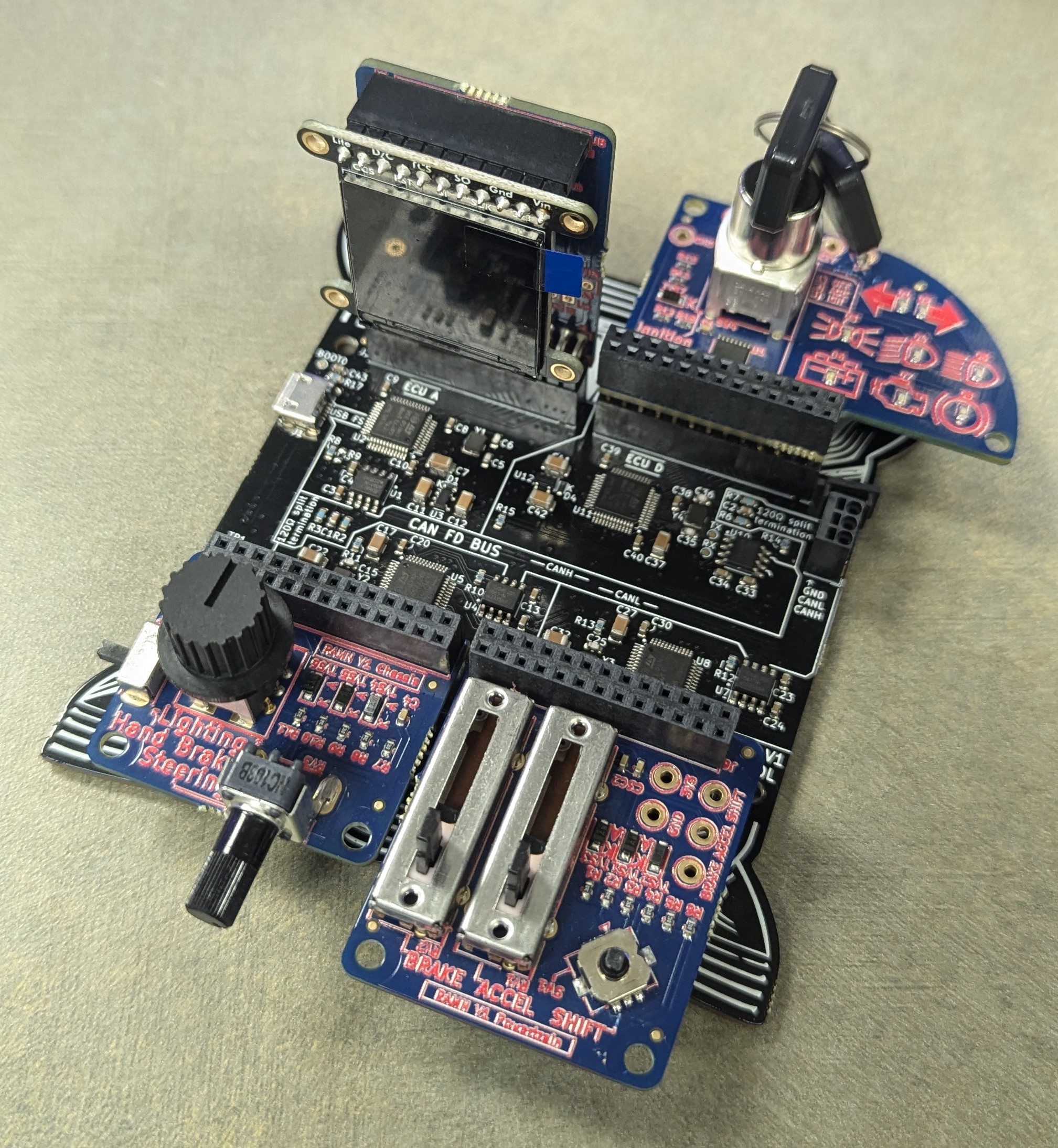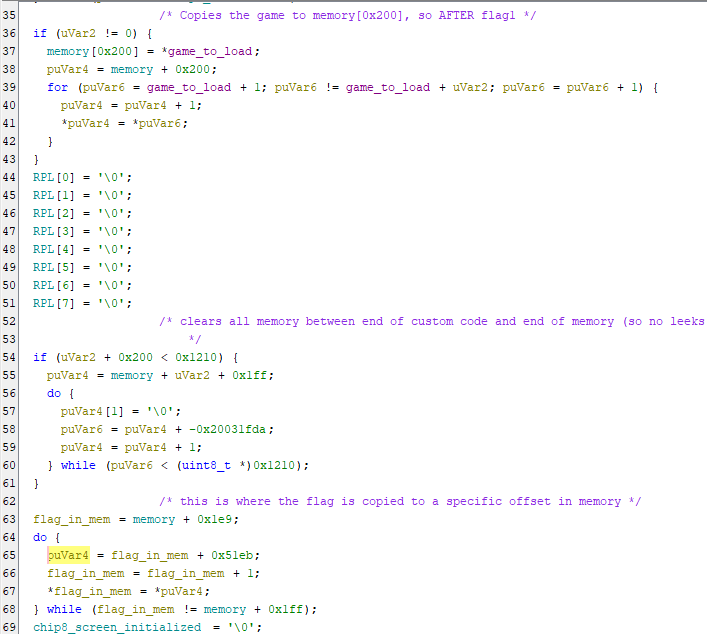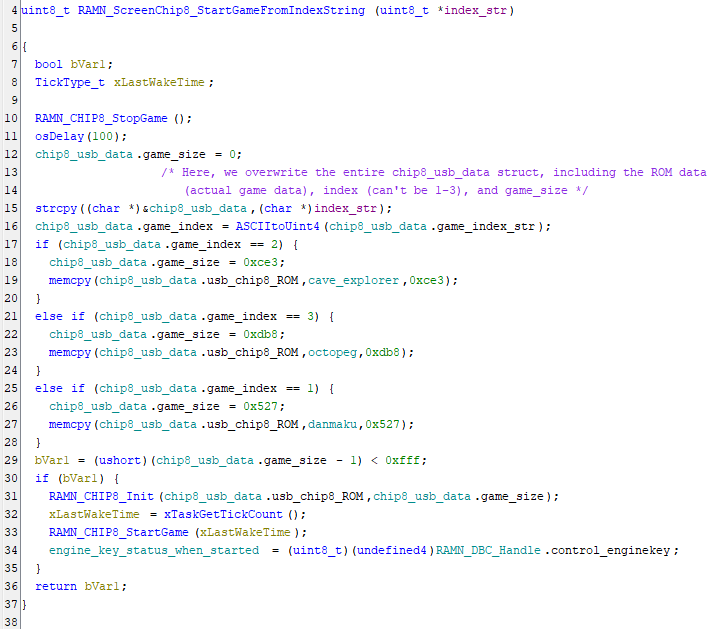Writeup - Let's Play a Game (ESVCTF 2024)
ESVCTF 2024 - Let’s Play a Game
Description
1 | ECU A |
Writeup
The Embedded System Village CTF was held at DEFCON 32 over a period of just over 2 days. When teams reached 10,000 points, they were provided a Toyota RAMN board, a piece of equipment designed to emulate the system of a car. It emulated a CAN Bus with 4 ECUS - A, B, C, and D. While the firmware for the equipment is open-source, in this case it was modified to include vulnerabilities and flags for the CTF.

For this challenge, an ELF running on ECU A was provided which emulated the 8-bit CHIP-8 architecture. The ELF provided included redacted flags so you’d know where the actual flags were located; note that the non-redacted version of the ELF was stored and running on the provided physical RAMN board, so exploiting it on the device would reveal the actual flag.
Interfacing with the Board
After wading through the documentation for a little bit, I found a section on connecting through USB. I downloaded the provided drivers, connected it with a USB cord that supports more than just power, and found out what COM port it was available on using the Windows Device Manager (COM5 in my case). I initially used PuTTY to interface with the serial device (baud rate of 9600), but ended up moving to PySerial for my exploit.
I had to change the terminal settings to force local echo and enable implicit LF in every CR for it to appear right, but this is what it looks like when I was plugged in:

Challenge Recon
The description told us the first flag was located somewhere in memory, and if we could load our own game we could retrieve it. The output for file ECUA.elf was:
1 | ECUA.elf: ELF 32-bit LSB executable, ARM, EABI5 version 1 (SYSV), statically linked, with debug_info, not stripped |
Not only was it not stripped, it was compiled with debug symbols and very easy to reverse in Ghidra. You’ll note it’s a 32-bit ARM binary and not CHIP-8. This particular binary implements the CHIP-8 architecture as a VM, with global variables for the memory and registers. It was not compiled with any mitigations.
A quick search for flag reveals the string flag{REDACTED_FLAG_1} which is referenced once in the RAMN_CHIP8_Init() function. Some quick reversing showed how CHIP-8 games are loaded to be ran. The bytes for the game (provided as an argument to the function) were copied to the global variable memory starting at offset 0x200. Then, all bytes from the game to the end of the memory variable were cleared (to prevent info leaks). Lastly, flag1 was copied to memory from offset 0x1e9 to 0x1ff. This means if we could load our own game, all we would have to do is leak/print out the bytes stored at those addresses.

Okay, so now we needed to figure out how to:
- Load our own custom game
- Write CHIP-8 assembly code that would leak the flag at address
0x1e9
Loading Our Custom Game
By looking at the references to the RAMN_CHIP8_Init() function, I found one call inside the RAMN_ScreenChip8_StartGameFromIndexString()

Here, we can see that the game being loaded comes from the chip8_usb_data global variable, a custom struct that looks like this:

However, there is a buffer overflow here with the strcpy() function call. It’s copying the entire index_str argument into the beginning of the chip8_usb_data struct, so if the argument is longer than the 2 bytes set aside for the game_index_str attribute, it overwrites the rest of the struct. This means we can overwrite the usb_chip8_ROM attribute (storing the CHIP8 assembly code) and the game_size attribute. However, there are some checks we need to pass first:
- The
game_indexcan’t be 1, 2, or 3 - The
game_sizemust be between 0 and0xfffbut large enough to copy all the CHIP8 assembly over- The reason this exists is because the chip only has
0x1000memory addresses
- The reason this exists is because the chip only has
This function is called from RAMN_ReceiveUSBFunc(), where input from the USB connection is parsed as commands. If the play command is used, then the second argument is passed as the index_str to our vulnerable function. Note that the number of arguments is checked, so the index_str can’t have a space in it either.

Exploit Setup
Before I wrote the CHIP8 assembly code for our exploit, I wrote a short Python script that would trigger this overflow and run a custom game:
1 | import serial |
I connect to the COM5 port and overflow the chip8_usb_data struct with x’s and \x01s for the game_size so it passes all the checks. Running this shows b'Starting game.\r' on my computer and a crash on the small LED screen of the board.

Exploit
Since the CHIP8 crash displays memory before and after the crash for both the PC and I register, I figured an easy way to get the flag would be to simply set the I variable to the flag and write down the leaked values 6 bytes at a time. By following the simple ISA outlined on Wikipedia, I just used the assembly A1EC (or b'\xa1\xec') to set I to 0x1ec and leak the first 6 values of the flag. I then repeated this, incrementing the address, until I got all the flag values.
Solve script:
1 | import serial |

Flag - flag{CL053_T0_F0NTS_}